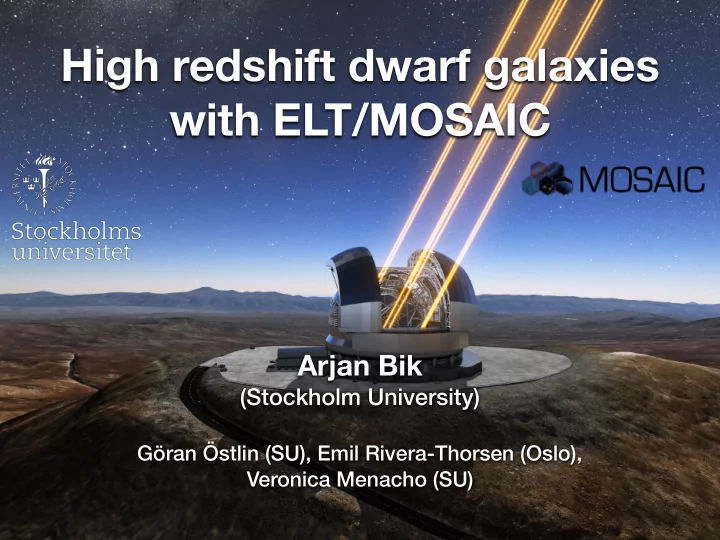

High redshift dwarf galaxies with ELT/MOSAIC Arjan Bik (Stockholm University) Göran Östlin (SU), Emil Rivera-Thorsen (Oslo), Veronica Menacho (SU)
Dwarf Galaxies • Λ -CDM cosmology: Hierarchical model of galaxy formation: • Small structures formed and merge to larger galaxies (White & Rees 1978). • Many more dwarf galaxies in the early universe. Steepening of the galaxy luminosity function at high z (e.g. Mortlock et al. 2015). • Candidates for re-ionization of the universe (Bouwens et al, 2016). • At high redshift: mostly star forming
Blue Compact (Dwarf) Galaxies • Use local analogues of high-redshift dwarf galaxies. • Strongly star forming, dozens of super star clusters • within a few 100 Mpc • HST Lya imaging & BB imaging, COS UV spectroscopy (LARS: Östlin et al, 2014, Hayes et al, 2014) • VLT/MUSE integral field spectroscopy Optical Lya, UV, Ha UV, optical, Ha
Blue Compact Galaxies MASS DISTANCE SFR Haro 11 12+LOG(O/H) (MPC) (M sun ) (M SUN /YR) 9x10 9 stars HARO 11 88 8.1-8.3 22.0 5.1x10 8 HI 4x10 9 stars 7.9 3.2 ESO 338 37.5 ESO 338-IG04 1.4x10 9 HI 7X10 7 stars SBS 0335 54 7.3 1.3 4.2X10 8 HI References: Östlin et al, 1998, Östlin et al, 2001, Bergvall & Östlin 2002, Cannon et al, 2004, Guseva et al, 2012, Adamo et al, 2010; Bergvall SBS-0335-052E 2006, Pardy et al, 2016, Guseva et al, 2012, Ekta et al, 2009
Blue Compact Galaxies MASS DISTANCE SFR Haro 11 12+LOG(O/H) (MPC) (M sun ) (M SUN /YR) 9x10 9 stars HARO 11 88 8.1-8.3 22.0 5.1x10 8 HI 4x10 9 stars 7.9 3.2 ESO 338 37.5 ESO 338-IG04 1.4x10 9 HI 7X10 7 stars SBS 0335 54 7.3 1.3 4.2X10 8 HI References: Östlin et al, 1998, Östlin et al, 2001, Bergvall & Östlin 2002, Cannon et al, 2004, Guseva et al, 2012, Adamo et al, 2010; Bergvall SBS-0335-052E 2006, Pardy et al, 2016, Guseva et al, 2012, Ekta et al, 2009
MUSE @z~0 • Spatially resolved kinematics: galaxy scale outflow • No ordered rotation: outflows, mergers ect… ESO 338-IG04 SBS-0335-052E Bik et al, 2015 Herenz et al, 2017
MUSE @z~0 • Ionisation mapping [OIII]/Halpha: • Ionisation cones where LyC is likely to escape • Halos are density bound, LyC could leak out ESO338 Haro 11 Bik et al, 2018 Menacho et al, submitted
• HDM mode: small IFUs with a spatial sampling of 0.08”/ pixel, R=5000 of selected galaxies • HMM mode: integrated spectra of many faint, high z dwarf galaxies • We expect 1 Haro 11 type galaxy per 0.1 z bin in a MOSAIC FOV. • Many more lower mass galaxies: ideal for MOSAIC • Websim/COMPASS (Puech et al., 2016) simulations to predict observables with ELT/MOSAIC
• Can we spatially resolve the halos of high-z BCDs? • Kinematics • Ionization parameter • abundances • 0.45 - 1.8 micron: • Further and deeper: integrated • Halpha until z=1.7 light with the HMM • [OIII] until z=2.4 • MUSE data as input • Lya from z=3
Haro 11 with MOSAIC in 10h Halpha, z=0 z=0.5 z=1.0 1“=0.4 kpc 1“=6.3 kpc 1“=8.7 kpc z=1.5 [OIII], z=2.0 [OIII], z=2.4 1“=8.6 kpc 1“=8.3 kpc 1“=7.9 kpc
ESO 338 & SBS0335 Halpha, z=0 Halpha, z=1.0 [OIII], z=2.4 1“=0.2 kpc 1“=8.7 kpc 1“=7.9 kpc Halpha, z=1.0 Halpha, z=1.5 1“=0.03 kpc 1“=8.7 kpc 1“=8.6 kpc
Kinematics Haro 11 Halpha, z=0.02 Halpha, z=0.5
Kinematics ESO 338-IG04 v_Halpha, z=0 v_Halpha, z=0.5 v_Halpha, z=1.5 • Spatially resolved kinematics: galaxy scale outflow • No ordered rotation: outflows, mergers ect… • At high z: not that clear! Large structures will be visible.
Ionisation mapping OIII/Halpha, z=0.02 OIII/Hbeta, z=1.0 Haro 11
Ionisation mapping OIII/Halpha, z=0.02 OIII/Hbeta, z=1.0 Haro 11 PSF matching!! • OIII/SII (Pelligrini et al, 2012)
Abundances ESO 338-IG04 12+log(O/H) N/O Einy, Bik et al, in prep • With MUSE we can make 2D metallicity and N/O ratio maps —> trace assembly history, feedback by massive stars. • ELT/MOSAIC will enable this at high redshift.
Integrated light with HMM • High-multiplex mode: reach fainter galaxies (lower masses) • Metallicities (mass-metallicity relation) • global ionization, HeII, OIII/OII • rest frame UV stellar absorption features: what are the massive star properties at z=3 and beyond? • neutral ISM absorption lines.
Integrated light with HMM • High-multiplex mode: reach fainter galaxies (lower masses) • Metallicities (mass-metallicity relation) • global ionization, HeII, OIII/OII • rest frame UV stellar absorption features: what are the massive star properties at z=3 and beyond? • neutral ISM absorption lines. Wofford et al, 2011
Integrated light with HMM • High-multiplex mode: reach fainter galaxies (lower masses) • Metallicities (mass-metallicity relation) • global ionization, HeII, OIII/OII • rest frame UV stellar absorption features: what are the massive star properties at z=3 and beyond? • neutral ISM absorption lines. Wofford et al, 2011
Summary • The HDM mode of MOSAIC enables spatially resolved studies of low-mass starbursts to z ~ 2. • Spatially resolved kinematics: study in detail galaxy scale outflows. • Ionisation mapping: what is f_esc of LyC photons at z=1-2? (does it increase?) • Make spatially resolved abundance maps • HMM mode: fainter galaxies, absorption lines
Recommend
More recommend